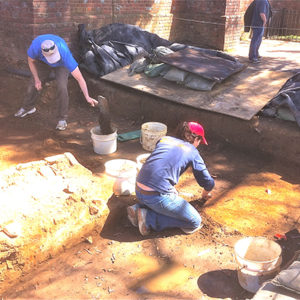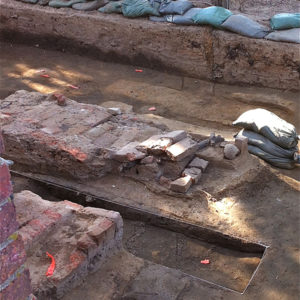As winter clung to eastern Virginia, the Jamestown Rediscovery archaeologists returned to the field in the first week of April and brought spring with them.
In a few days they were rewarded with both 80-degree days of sunshine and some unexpectedly undisturbed Fort period deposits enough to warrant more work in a section just south of the 1907 Memorial Church.
They opened this section last summer as part of a broader search of several sections on either side of the eastern palisade of James Fort. This is the only section from that excavation work still open. The work this month already recovered early fort period artifacts among the dozen or more graves crowded in to the space that is 20 feet by 20 feet.
So Dr. William M. Kelso, head of archaeological research at Historic Jamestowne, asked the team to dig deeper to try to clarify the maze of burials, post holes, and a trench left behind from the original James Fort palisade.
“I was leading a tour over there, and it was amazing to see the visitors faces when they could see the trench in the ground leading right to where we have rebuilt the palisade. It really made the connection for them,” Kelso said.
He hopes to find a pristine section of ground near the palisade to see how deep the original fort palisade went down.
By late April the archaeologists hope to move back to the L-shaped cellar in the middle of the fort in what is the 20st archaeological season of the Jamestown Rediscovery Project.
The cellar is 25 feet long and dates to the early James Fort period (1607-1610). It features two ovens that could have been used for baking bread, and it aligns with James Fort’s first storehouse and well cellar, which sits 10 feet away to the west.
Kelso said this year’s work will expand the look at the cellar to the east and to the south. The archaeologists will try to find signs of the extent of the superstructure over the cellar and whether that structure was attached to more public buildings.
In 2006 the Jamestown Rediscovery team found a cellar that was in use between 1607 and 1617, sometimes as a metalworking shop, sometimes as a bakery. That feature in the northern end of the fort had brick ovens and a brick flue that was about 10 inches thick. Such evidence points to a rectangular superstructure over the cellar—perhaps a roof set at about ground level and supported by posts set deep in the cellar floor. Kelso said that expanding the excavations around the L-shaped cellar in the middle of the fort may uncover evidence of similar posts and construction.
By this summer there will be multiple open sites for excavation. A trench will be opened to examine the area near the burial site of Bartholomew Gosnold to see if he was laid to rest all alone out beyond the western palisade of the fort. Kelso said the plan is to explore a 600 square foot area, which would be enough to locate possible graves and any other Fort period features located just beyond the west fort palisade wall.
The Civil War earthwork west of the James Fort footprint will also be tested, Kelso said. A simple 10-foot-wide trench will be dug near the shaded shrine to the Rev. Hunt. “Under the Civil War earthworks, we invariably find undisturbed areas of the Jamestown site. They built the earthwork right on the surface. So we want to get below that and the plow zone and then we find the 17th century,” Kelso said. “We think James Fort was expanded in both directions. The Civil War earthwork between the northern bulwark and the Dale House has not been looked at yet.”
A trench will also be opened along the brick graveyard wall by the 1907 Memorial Church, along the entrance path that extends west from the entrance gate to Preservation Virginia’s property on the western end of Jamestown Island. In planning to repair the graveyard wall at some point, it would be valuable to figure out the footing of the brick wall, Kelso said.
“We would go even deeper than the footings—that area is within the extended James Fort,” Kelso said. “Between that area and the graves there could be pristine remnants of the original fort.”
related images
- Jamestown Rediscovery archaeologists Don Warmke and Mary Anna Richardson began the 2013 dig season by removing more soil from a section south of the 1907 Memorial Church
- Volunteer archaeologist Gere Brown works by the reconstructed James Fort palisade, which was built a few inches off the trench made for the original palisade







